-
CATEGORY ::
- All Seeds /
- All Flower Seeds /
- All Foxglove Seeds








Foxglove Seeds - White
About...
Foxglove (Digitalis Purpurea Alba) - Lending an elegant air and grace to any garden design, the popular, but difficult to find, white Foxglove is a carefree treasure, and it is easily grown from Foxglove seeds! The sturdy 42 inch stalks are fully packed with huge trumpets of purest white from greenish-white buds.
MORE FOXGLOVE OPTIONS
Planting Directions
TEMPERATURE
65 - 70F
AVERAGE GERM TIME
20 - 30 days
LIGHT REQUIRED
No
DEPTH
Do not cover the seed but tightly press into the soil
SOWING RATE
4 - 6 seeds per plant
MOISTURE
Keep seeds moist until germination
PLANT SPACING
12 - 18 inches









Foxglove (Digitalis Purpurea Alba) - Lending an elegant air and grace to any garden design, the popular, but difficult to find, white Foxglove is a carefree treasure, and it is easily grown from Foxglove seeds!
Common Questions
How can I use foxglove in the landscape?
Use tall foxgloves in the landscape for the back row of mixed borders, to attract hummingbirds, and plant white foxglove flowers to brighten a moon garden.
Does foxglove spread aggressively?
Foxgloves freely self-seed, creating a sustained patch that produces flowers annually. However, foxglove is not considered an aggressive spreader.
How do I tell the difference between biennial and perennial foxgloves?
The common perennial type is the yellow foxglove (D. grandiflora), which has solid yellow flowers without the multiple colors found in biennials. If your foxglove has speckled colors in its throat, it is almost certainly a biennial that can be removed once the flowers are gone.
Will deer eat my foxglove plants?
No, deer tend to stay away from foxglove plants.
Do I need to prune back my flowers after blooms fade?
Cut back main flower spike as the blooms fade to encourage growth of flowering side shoots.
Is foxglove toxic?
Yes, foxglove is highly toxic if ingested. Wear gloves and wash your hands after handling. Toxic for dogs, cats, horses and humans.
Planting Directions
TEMPERATURE
60 - 65F
AVERAGE GERM TIME
20 - 30 days
LIGHT REQUIRED
No
DEPTH
Do not cover the seed but tightly press into the soil
SOWING RATE
1/4 ounce per 1,000 square feet or 1/2 pound per acre or 4 - 6 seeds per plant
MOISTURE
Keep seeds moist until germination
PLANT SPACING
12 - 18 inches









Foxglove (Digitalis Purpurea Excelsior Mix) - This mix is perfect for the cottage garden or bordering the back of the perennial garden. These tall stately beauties easily establish from Foxglove seeds. This biennial or short-lived perennial produces spires of large tubular flowers that are enchanting vertical accents in the sun or partial shade garden. The flowers are in colors that include cream, pink, purple, yellow and white. They bloom in late spring or early summer and if the main spike is cut, side shoots will develop and flower until September. Foxgloves look wonderful in a woodland setting, and they attract hummingbirds and butterflies.
Sow Foxglove wildflower seeds in late spring to early summer outdoors in a well prepared seed bed. Sow the seeds on the surface and press them in gently. Keep the flower seeds and soil damp until germination takes place.
Common Questions
How can I use foxglove in the landscape?
Use tall foxgloves in the landscape for the back row of mixed borders, to attract hummingbirds, and plant white foxglove flowers to brighten a moon garden.
Does foxglove spread aggressively?
Foxgloves freely self-seed, creating a sustained patch that produces flowers annually. However, foxglove is not considered an aggressive spreader.
How do I tell the difference between biennial and perennial foxgloves?
The common perennial type is the yellow foxglove (D. grandiflora), which has solid yellow flowers without the multiple colors found in biennials. If your foxglove has speckled colors in its throat, it is almost certainly a biennial that can be removed once the flowers are gone.
Will deer eat my foxglove plants?
No, deer tend to stay away from foxglove plants.
Do I need to prune back my flowers after blooms fade?
Cut back main flower spike as the blooms fade to encourage growth of flowering side shoots.
Is foxglove toxic?
Yes, foxglove is highly toxic if ingested. Wear gloves and wash your hands after handling. Toxic for dogs, cats, horses and humans.
Planting Directions
TEMPERATURE
65 - 70F
AVERAGE GERM TIME
20 - 30 days
LIGHT REQUIRED
No
DEPTH
Do not cover the seed but tightly press into the soil
SOWING RATE
2 - 3 seeds per plant
MOISTURE
Keep seeds moist until germination
PLANT SPACING
15 inches




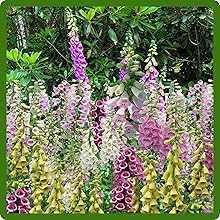
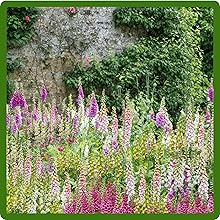

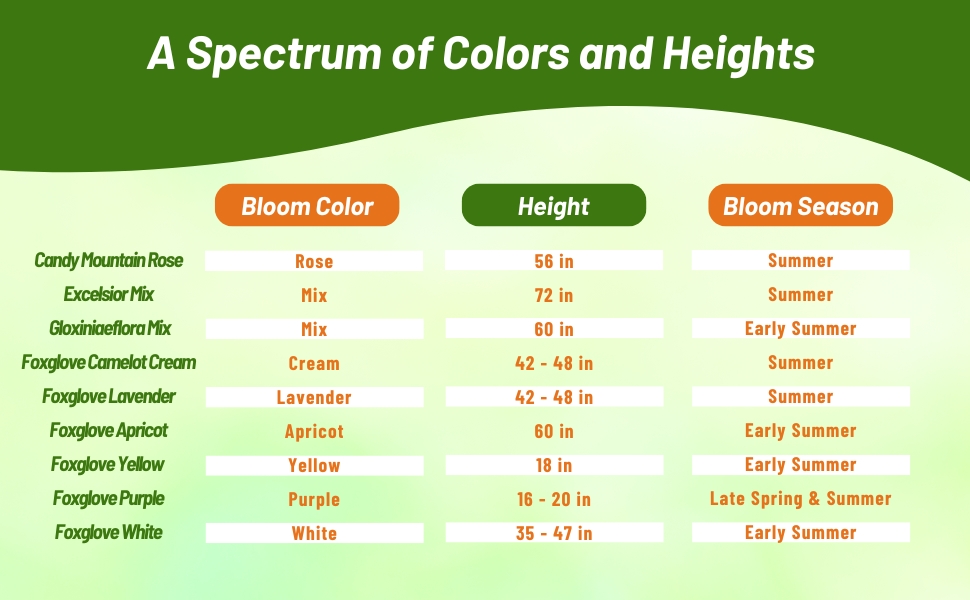

Foxglove (Digitalis Ambiqua Temple Bells Yellow) - Many Foxgloves are short-lived biennials, but this is a true perennial. It readily grows from flower seeds, and it gives plenty of colorful blooms. This yellow Foxglove will return for many years gracing the garden or flower border with its elegance.
Common Questions
How can I use foxglove in the landscape?
Use tall foxgloves in the landscape for the back row of mixed borders, to attract hummingbirds, and plant white foxglove flowers to brighten a moon garden.
Does foxglove spread aggressively?
Foxgloves freely self-seed, creating a sustained patch that produces flowers annually. However, foxglove is not considered an aggressive spreader.
How do I tell the difference between biennial and perennial foxgloves?
The common perennial type is the yellow foxglove (D. grandiflora), which has solid yellow flowers without the multiple colors found in biennials. If your foxglove has speckled colors in its throat, it is almost certainly a biennial that can be removed once the flowers are gone.
Will deer eat my foxglove plants?
No, deer tend to stay away from foxglove plants.
Do I need to prune back my flowers after blooms fade?
Cut back main flower spike as the blooms fade to encourage growth of flowering side shoots.
Is foxglove toxic?
Yes, foxglove is highly toxic if ingested. Wear gloves and wash your hands after handling. Toxic for dogs, cats, horses and humans.
Planting Directions
TEMPERATURE
65 - 70F
AVERAGE GERM TIME
20 - 30 days
LIGHT REQUIRED
No
DEPTH
Do not cover the seed but tightly press into the soil
SOWING RATE
4 - 6 seeds per plant
MOISTURE
Keep seeds moist until germination
PLANT SPACING
12 - 18 inches



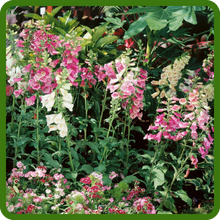



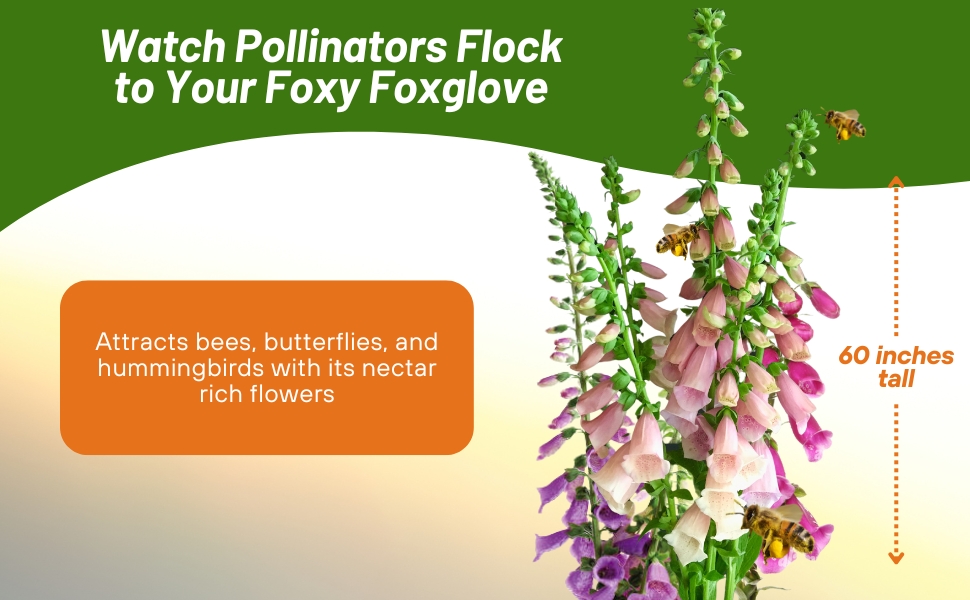

Foxglove (Digitalis Purpurea Foxy) - Colorful, prolific, and long-blooming, Foxglove Foxy is a reliable show-stealer in the early-summer garden, and they easily grow from flower seeds. These abundantly bushy plants produce big blooms of white, cream, yellow, and rosy-red. Many of the blooms have charming spots of red inside the bell-shaped tubes. And the best part? They appear just 5 months after sowing Foxglove seeds, so you can grow this lovely flower even in areas where it isn't hardy! 1967 AAS Flower Winner.
Common Questions
How can I use foxglove in the landscape?
Use tall foxgloves in the landscape for the back row of mixed borders, to attract hummingbirds, and plant white foxglove flowers to brighten a moon garden.
Does foxglove spread aggressively?
Foxgloves freely self-seed, creating a sustained patch that produces flowers annually. However, foxglove is not considered an aggressive spreader.
How do I tell the difference between biennial and perennial foxgloves?
The common perennial type is the yellow foxglove (D. grandiflora), which has solid yellow flowers without the multiple colors found in biennials. If your foxglove has speckled colors in its throat, it is almost certainly a biennial that can be removed once the flowers are gone.
Will deer eat my foxglove plants?
No, deer tend to stay away from foxglove plants.
Do I need to prune back my flowers after blooms fade?
Cut back main flower spike as the blooms fade to encourage growth of flowering side shoots.
Is foxglove toxic?
Yes, foxglove is highly toxic if ingested. Wear gloves and wash your hands after handling. Toxic for dogs, cats, horses and humans.
Planting Directions
TEMPERATURE
65 - 70F
AVERAGE GERM TIME
20 - 30 days
LIGHT REQUIRED
No
DEPTH
Do not cover the seed but tightly press into the soil
SOWING RATE
4 - 6 seeds per plant
MOISTURE
Keep seeds moist until germination
PLANT SPACING
12 - 18 inches


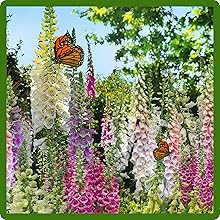






Foxglove (Digitalis Purpurea Gloxiniaeflora) - Grow this tall, elegant flower from Foxglove seeds! This Foxglove mix has a soothing combination of pastel cream, rose, lavender and white colored blooms. Foxglove makes a great addition to any home flower garden. Make your home and garden fantastic with the addition of this Foxglove flower seed mix.
Common Questions
How can I use foxglove in the landscape?
Use tall foxgloves in the landscape for the back row of mixed borders, to attract hummingbirds, and plant white foxglove flowers to brighten a moon garden.
Does foxglove spread aggressively?
Foxgloves freely self-seed, creating a sustained patch that produces flowers annually. However, foxglove is not considered an aggressive spreader.
How do I tell the difference between biennial and perennial foxgloves?
The common perennial type is the yellow foxglove (D. grandiflora), which has solid yellow flowers without the multiple colors found in biennials. If your foxglove has speckled colors in its throat, it is almost certainly a biennial that can be removed once the flowers are gone.
Will deer eat my foxglove plants?
No, deer tend to stay away from foxglove plants.
Do I need to prune back my flowers after blooms fade?
Cut back main flower spike as the blooms fade to encourage growth of flowering side shoots.
Is foxglove toxic?
Yes, foxglove is highly toxic if ingested. Wear gloves and wash your hands after handling. Toxic for dogs, cats, horses and humans.
Planting Directions
TEMPERATURE
65 - 70F
AVERAGE GERM TIME
20 - 30 days
LIGHT REQUIRED
No
DEPTH
Do not cover the seed but tightly press into the soil
SOWING RATE
4 - 6 seeds per plant
MOISTURE
Keeps seeds moist until germination
PLANT SPACING
12 - 18 inches









Foxglove (Digitalis Purpurea Apricot Beauty) - Growing Foxglove seeds is a wonderful way to establish this unique Apricot Beauty variety in your flower border. Foxglove apricot produces gorgeous, pastel shades of apricot-orange blooms that are lightly spotted.
Common Questions
How can I use foxglove in the landscape?
Use tall foxgloves in the landscape for the back row of mixed borders, to attract hummingbirds, and plant white foxglove flowers to brighten a moon garden.
Does foxglove spread aggressively?
Foxgloves freely self-seed, creating a sustained patch that produces flowers annually. However, foxglove is not considered an aggressive spreader.
How do I tell the difference between biennial and perennial foxgloves?
The common perennial type is the yellow foxglove (D. grandiflora), which has solid yellow flowers without the multiple colors found in biennials. If your foxglove has speckled colors in its throat, it is almost certainly a biennial that can be removed once the flowers are gone.
Will deer eat my foxglove plants?
No, deer tend to stay away from foxglove plants.
Do I need to prune back my flowers after blooms fade?
Cut back main flower spike as the blooms fade to encourage growth of flowering side shoots.
Is foxglove toxic?
Yes, foxglove is highly toxic if ingested. Wear gloves and wash your hands after handling. Toxic for dogs, cats, horses and humans.
Planting Directions
TEMPERATURE
65 - 70F
AVERAGE GERM TIME
20 - 30 days
LIGHT REQUIRED
No
DEPTH
Do not cover the seed but tightly press into the soil
SOWING RATE
4 - 6 seeds per plant
MOISTURE
Keep seeds moist until germination
PLANT SPACING
18 - 24 inches



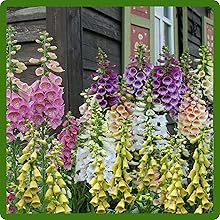


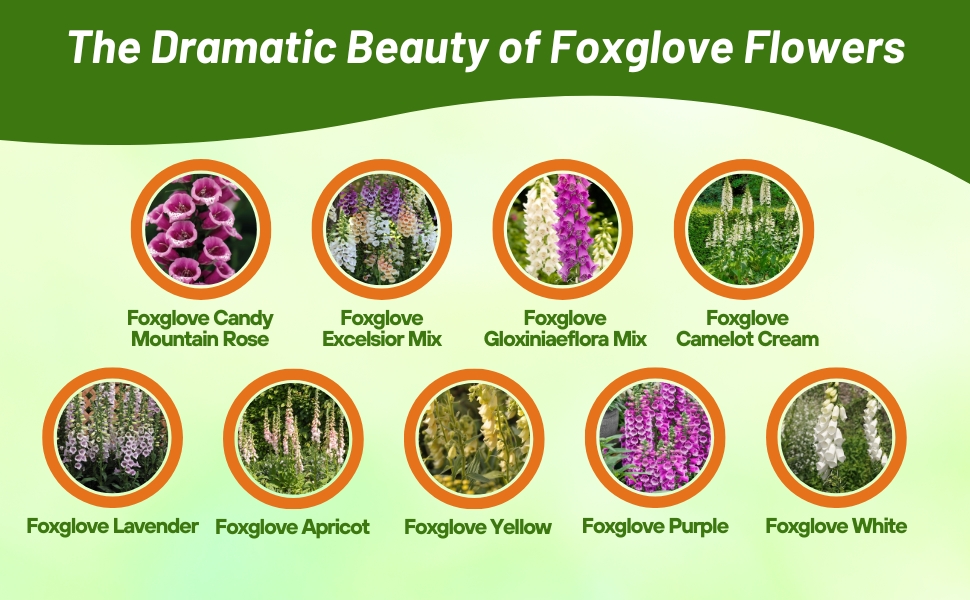


Foxglove (Digitalis Purpurea Camelot Cream) - Dramatic cream colored flowers attract hummingbirds to the garden. Beautiful in a wooded setting with goatsbeard, cimicifuga or snowdrop Anemone. Divide after blooming or allow to self-seed to keep these lovely plants in the garden for years to come. This long last cutflower reaches 42 - 48 inches in height and 15 - 24 inches wide. Grows in full sun or partial shade.
To grow Digitalis Purpurea from flower seed begin with rich, moist soil. Space the Foxglove plants 18 - 24 inches apart. Sow Foxglove seeds outdoors directly into prepared soil in the spring after danger of frost has passed in full sun or partial shade.
Common Questions
How can I use foxglove in the landscape?
Use tall foxgloves in the landscape for the back row of mixed borders, to attract hummingbirds, and plant white foxglove flowers to brighten a moon garden.
Does foxglove spread aggressively?
Foxgloves freely self-seed, creating a sustained patch that produces flowers annually. However, foxglove is not considered an aggressive spreader.
How do I tell the difference between biennial and perennial foxgloves?
The common perennial type is the yellow foxglove (D. grandiflora), which has solid yellow flowers without the multiple colors found in biennials. If your foxglove has speckled colors in its throat, it is almost certainly a biennial that can be removed once the flowers are gone.
Will deer eat my foxglove plants?
No, deer tend to stay away from foxglove plants.
Do I need to prune back my flowers after blooms fade?
Cut back main flower spike as the blooms fade to encourage growth of flowering side shoots.
Is foxglove toxic?
Yes, foxglove is highly toxic if ingested. Wear gloves and wash your hands after handling. Toxic for dogs, cats, horses and humans.
Planting Directions
TEMPERATURE
65 - 70F
AVERAGE GERM TIME
20 - 30 days
LIGHT REQUIRED
No
DEPTH
Do not cover the seed but tightly press into the soil
SOWING RATE
4 - 6 seeds per plant
MOISTURE
Keep seeds moist until germination
PLANT SPACING
18 - 24 inches


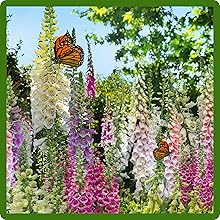



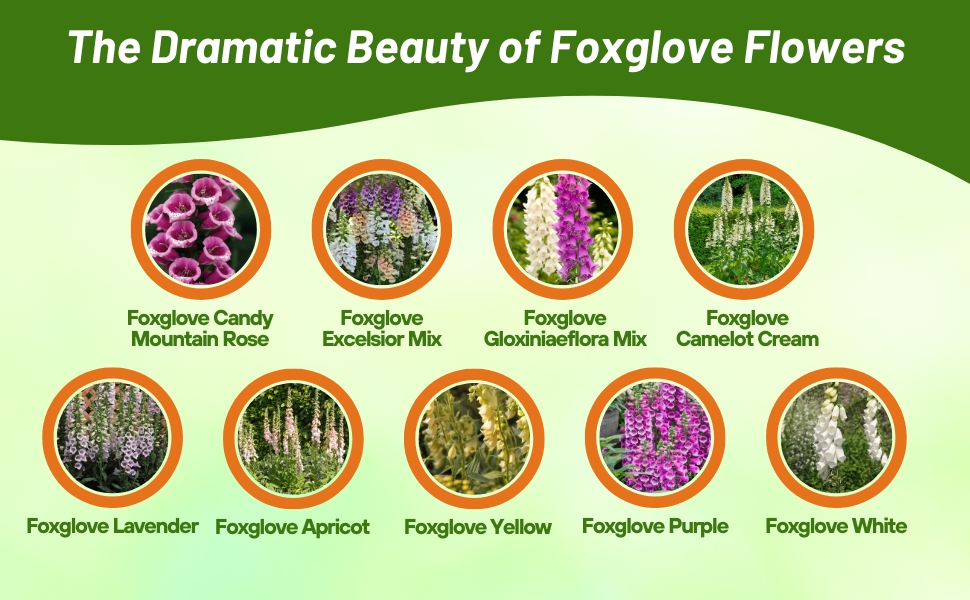
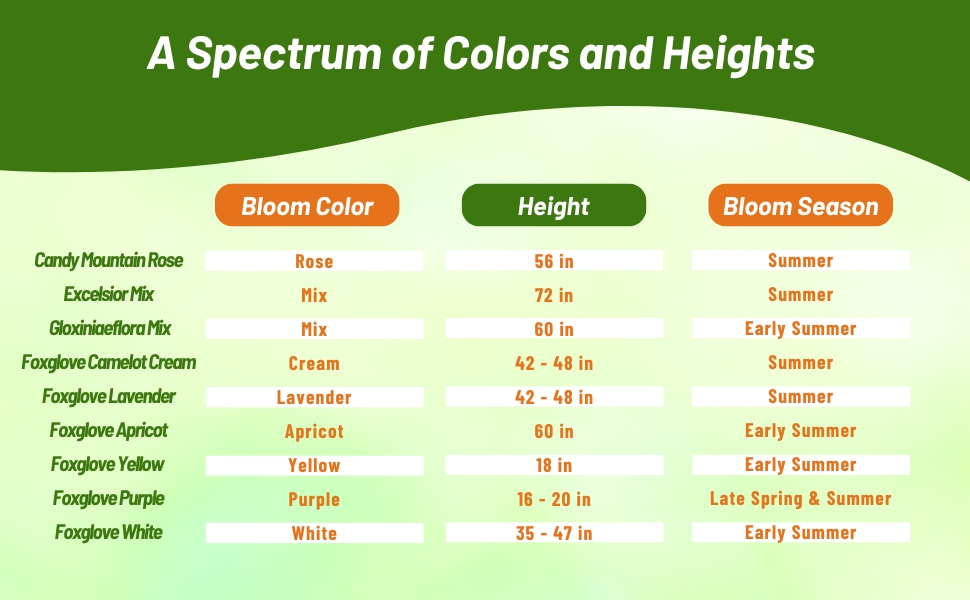

Foxglove (Digitalis Purpurea Camelot Lavender) - Foxglove adds elegance and grace to the summer garden with large, lilac-colored flowers and maroon-speckled interiors. Attracts butterflies and hummingbirds, but not deer and rabbits. "Camelot Lavender" is the perfect choice for planting near your favorite sitting spot in any sunny to partly-shaded garden. These plants grows 42 - 48 inches tall and make great cut flowers.
To grow Digitalis Purpurea from flower seed begin with rich, moist soil. Space the Foxglove plants 18 - 24 inches apart. Sow Foxglove seeds outdoors directly into prepared soil in the spring after danger of frost has passed in full sun or partial shade.
Common Questions
How can I use foxglove in the landscape?
Use tall foxgloves in the landscape for the back row of mixed borders, to attract hummingbirds, and plant white foxglove flowers to brighten a moon garden.
Does foxglove spread aggressively?
Foxgloves freely self-seed, creating a sustained patch that produces flowers annually. However, foxglove is not considered an aggressive spreader.
How do I tell the difference between biennial and perennial foxgloves?
The common perennial type is the yellow foxglove (D. grandiflora), which has solid yellow flowers without the multiple colors found in biennials. If your foxglove has speckled colors in its throat, it is almost certainly a biennial that can be removed once the flowers are gone.
Will deer eat my foxglove plants?
No, deer tend to stay away from foxglove plants.
Do I need to prune back my flowers after blooms fade?
Cut back main flower spike as the blooms fade to encourage growth of flowering side shoots.
Is foxglove toxic?
Yes, foxglove is highly toxic if ingested. Wear gloves and wash your hands after handling. Toxic for dogs, cats, horses and humans.
































